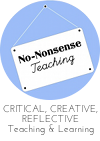The use of explicit criteria provides children the opportunity to receive meaningful feedback from a variety of sources including themselves, peers, parents and teachers. Embedding criteria into everyday teaching and learning requires some thinking about how children can use this tool in meaningful ways.
Maybe one or all of these suggestions will work for you:
1. Connect assessment for learning criteria with descriptive feedback.
At the end of a lesson (Sharing Time), ask children to share two aspects from the criteria list they thought they did well that day. Ask them to provide evidence from their work to support their thinking. Ask children to share one aspect of the criteria they think needs improvement. Ask them again to provide evidence from their work to support their thinking. Ask how they think they can improve this aspect of their work. If they have no suggestions, they ask the class or their partner for suggestions. This activity may be done with a few children sharing with the whole class or in partners.
2. Look for patterns.
Our brains are pattern seekers! Children need to see that each criteria is not completely different and there are underlying commonalities between criteria. Children will better internalize commonalities when explicitly taught.
As a class, look at your list of criteria (items) and group them into categories. Choose an appropriate title to describe each category. The categories become the criteria and the original list of items become specifics which describe each criterion. When sharing and assessing, children use the specifics to provide descriptive feedback.
3. Color Code categorized criteria.
Once criteria is organized into categories, give each category a color. Be consistent from criteria to criteria using the same color for the same category. For example, if one of your reading criteria is called 'Own Thinking' and another one called 'Evidence' you might choose to use green lettering when writing 'Own Thinking' and the specifics that support that criteria. For 'Evidence', you might choose to use blue marker when creating your Success Criteria chart.
Color coding is used as an assessment for learning strategy. When using criteria to self-assess, children are asked to underline evidence in their work that support their self-assessment. For example, if a child self-assesses believing they have incorporated their 'Own Thinking', in their work, they would underline an example of their 'Own Thinking' in green to match the criteria chart.
The teacher can then quickly assess to see if that child understands the meaning of 'Own Idea'. The child is also required to slow down and truly self-assess rather than quickly checking off a list of criteria with little reflection.
To learn more about the No-Nonsense way of teaching, check out my store:
http://www.teacherspayteachers.com/Store/No-nonsense-Teaching































1 comment:
I love these ideas! Great assessment tools that aren't just testing. Thanks for sharing!
Wife Teacher Mommy
Post a Comment